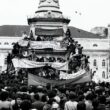“Rashers, applying his mind to the matter, began at the beginning. Anything that lived; men, women, children; dogs, pigeons, monkeys; even lesser things like cockroaches, flies and fleas, had to eat. He had been of their company for long enough to sympathise with them all – the child rooting in the ashbin, the cat slinking along the gutter, the cockroach delicately questing along the wooden joins of the floor, its grey blue body corrugated with anxiety. These were sometimes his competitors, but more often his brothers. He could never watch a dog nosing in a bin without a feeling of sympathy and fellowship.”
Rashers Tierney, the ne’er-do-well occupant of the basement of Chandler’s Court, a Dublin city tenement, personifies the humanity, humour and tragedy that emanate from James Plunkett’s masterpiece novel, Strumpet City, set preceding and during the 1913 Lockout. The epic nature of this struggle is echoed by the epic nature of a novel, that not only is an elegy to the “kip of a city”, Dublin, but also, through a host of characters representing the various social strata, from Lily the prostitute, to O’Connor, the supercilious priest; from Mr. Bradshaw the slum-landlord, to Fitz and Mary, the working class couple; Plunkett weaves a tapestry that colourfully illustrates all aspects of life at the time.
The complexity of characters like Fr. Giffley and Yearling; the former a Catholic orthodoxy questioning, alcoholic priest who’s in the midst of a breakdown; the latter a bonifide member of the bourgeoisie who remains aloof from the majority of his contemporaries in the boss class and is affected by the struggle of the time, questioning the status quo in the abstract as the class war wages around him and his own company board agree to aid William Martin Murphy in his quest to smash ‘Larkinism’; Plunkett’s own sympathies do not impede his depiction.
Plunkett’s empathy with the oppressed and with the working class is, however, embedded in the novel. The character of Rashers shows Plunkett’s empathy best. Rashers whose Dublin humour no doubt has been a source of mirth and joy for readers all around the world, will be a source of particular delight to those from the city, particularly the working class communities, who will be familiar with Rashers’s way of making light, using irony and self-deprecation, as well as his pride. Rashers is conflated to a god-like position in his lowliness – Rashers is too impoverished and marginalised to even be a participant in the great class war of 1913 – his role therefore is as overseer, as commentator, even as a symbol in fact for the battle itself, for the brutal suffering of the working class at the time. But in playing this role, Rashers is never dehumanised – at the core of “Strumpet City” is Rashers Tierney – is humanity.
The spectres haunting Dublin in “Strumpet City” are Larkin and William Martin Murphy. Martin Murphy is an ominous force. We do not meet him in person but sense his menacing power and influence. Larkin is present in the novel in important scenes and moments, but it’s the feelings that the ordinarily stoical, manual worker and union activist, Mulhall displays towards Big Jim, that really depict his greatness – the warmth, the loyalty, the love. “Strumpet City” gives an insight into the force of working class unity and power in struggle, as well as the optimism and hope that socialist ideas – that so naturally flow from the latter – provide. Fitz’s sacrifices for the struggle, for him, were the only option:
“Why? Personal pride, or the hope that at the end of so much travail, somewhere in the unseeable future, there would be a change in the world.”











